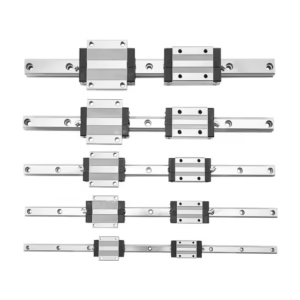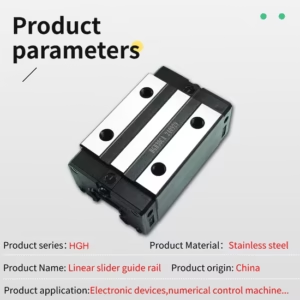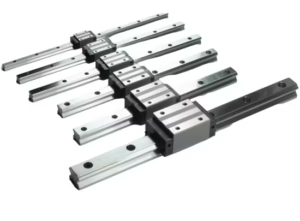Outline for Long-form Article on Linear Bearings and Rails
| Section | Subtopics |
|---|---|
| Introduction | What are linear bearings and rails? Why they matter |
| Linear Bearings and Rails | Definition, function, and importance |
| Evolution of Linear Motion Systems | From sliding bearings to precision rails |
| Types of Linear Bearings | Ball bearings, roller bearings, plain bearings |
| Types of Linear Rails | Profile rails, round rails, miniature rails |
| Core Components | Rail, carriage, rolling elements, lubrication |
| How Linear Bearings and Rails Work | Mechanics of motion, load transfer |
| Advantages of Linear Bearings and Rails | Precision, rigidity, smooth operation |
| Challenges and Limitations | Cost, installation, maintenance |
| Applications in CNC Machines | Milling, turning, laser cutting |
| Applications in Robotics | Arm motion, pick-and-place, cobots |
| Applications in Medical Equipment | Imaging, surgery, diagnostics |
| Applications in Aerospace and Defense | Aircraft assembly, simulators |
| Applications in Packaging and Logistics | Conveyors, pickers, warehouses |
| Linear Bearings and Rails vs Other Motion Systems | Wheels, belts, bushings |
| Choosing the Right System | Load, environment, speed, budget |
| Installation Best Practices | Alignment, fastening, testing |
| Maintenance and Longevity | Cleaning, lubrication, inspection |
| Common Failures | Misalignment, wear, contamination |
| Future Innovations | Smart rails, AI-driven predictive maintenance |
| Sustainability in Linear Motion Systems | Green materials, energy efficiency |
| Top Manufacturers Worldwide | THK, HIWIN, Bosch Rexroth |
| DIY and Maker Projects | 3D printers, CNC routers, laser engravers |
| Cost Considerations | Budget, performance trade-offs |
| Buying Guide | Where to buy, what to check |
| Linear Bearings and Rails | Recap and importance |
| FAQs | At least six questions answered |
| Conclusion | Summary and future outlook |
Introduction
Modern machines rely on movement that is precise, smooth, and reliable. From a robotic arm assembling cars to a 3D printer creating prototypes, precision matters. This is where linear bearings and rails shine.
These systems make sure that components move in a straight line without unwanted wobble or resistance. Unlike wheels, belts, or sliders, linear bearings and rails use rolling elements to reduce friction while carrying heavy loads. They are the silent heroes behind CNC machining, automation, robotics, aerospace, and medical technologies.
Linear Bearings and Rails
At their simplest, linear bearings and rails are designed to guide and support movement along a straight path. The rail serves as the track, while the bearing or carriage moves along it with the help of rolling elements like balls or rollers.
Key characteristics include:
- High precision – essential in industries like aerospace and electronics.
- Load-bearing capacity – supports light to heavy equipment.
- Smooth operation – reduces friction, vibration, and noise.
Without linear bearings and rails, most of today’s precision engineering and automation systems would not exist.
Evolution of Linear Motion Systems
Before the advent of linear rails, industries used sliding bushings or plain bearings. These worked but generated high friction, required constant lubrication, and wore out quickly.
The introduction of recirculating ball linear bearings changed the game. Suddenly, machines could achieve micrometer-level accuracy with long operational life. Over time, designs evolved into:
- Profile rail guides – for high rigidity.
- Miniature rails – for compact applications.
- Heavy-duty rails – for industrial machinery.
Today, advancements include self-lubricating bearings, corrosion-resistant coatings, and smart monitoring systems.
Types of Linear Bearings
- Ball Bearings
- Use steel balls for low friction.
- Common in CNC and robotics.
- Roller Bearings
- Use cylindrical rollers for higher load capacity.
- Found in heavy industry applications.
- Plain Bearings (Bushings)
- No rolling elements, just sliding motion.
- Cost-effective, but less precise.
Types of Linear Rails
- Profile Rails
- Square edges, extremely rigid.
- Used in CNC machining, aerospace.
- Round Rails
- Easier installation, forgiving of misalignment.
- Common in packaging, logistics.
- Miniature Rails
- Small, lightweight, ultra-precise.
- Used in medical and electronics.
Core Components
- Rails – Precision-ground tracks.
- Carriages/Bearings – Move along rails.
- Rolling Elements – Balls or rollers reduce friction.
- Seals & Shields – Keep dust out.
- Lubrication Systems – Ensure smooth motion.
How Linear Bearings and Rails Work
The principle is straightforward. Rolling elements circulate inside the carriage, allowing it to move smoothly along the rail. This recirculation mechanism ensures continuous contact and stability.
Loads are distributed across multiple contact points, which improves rigidity and prevents deflection under stress.
Advantages of Linear Bearings and Rails
- High precision motion
- Long service life
- Ability to carry heavy loads
- Reduced friction and energy loss
- Compact design
- Low noise
Challenges and Limitations
- Higher initial cost
- Sensitive to contamination (dust, dirt)
- Require precise installation
- Periodic lubrication needed
Applications in CNC Machines
CNC machining demands micron-level accuracy. Linear bearings and rails are used in:
- Milling machines
- Laser cutters
- Water jet machines
- 3D printers
They ensure the cutting tool moves with stability and consistency.
Applications in Robotics
Robots need precise and repeatable movements. Linear bearings and rails are critical in:
- Robotic arms
- Pick-and-place systems
- Collaborative robots (cobots)
Applications in Medical Equipment
Healthcare relies on accuracy. Linear bearings and rails are used in:
- MRI and CT scanners
- Robotic surgical systems
- Laboratory automation devices
Applications in Aerospace and Defense
- Aircraft wing assembly
- Flight simulators
- Satellite positioning systems
These require rigid, vibration-resistant systems.
Applications in Packaging and Logistics
- Conveyor systems
- Automated warehouses
- High-speed labeling machines
Smooth motion ensures efficiency and reduced downtime.
Linear Bearings and Rails vs Other Motion Systems
| Feature | Linear Bearings & Rails | Wheels/Belts | Bushings |
|---|---|---|---|
| Precision | Very High | Medium | Low |
| Load Capacity | High | Medium | Low |
| Friction | Very Low | Medium | High |
| Cost | Higher | Lower | Lowest |
Choosing the Right System
Key considerations include:
- Load requirements
- Speed of operation
- Environmental conditions
- Budget and maintenance needs
Installation Best Practices
- Ensure rail alignment
- Use clean, flat mounting surfaces
- Apply recommended torque levels
- Test for smooth motion before operation
Maintenance and Longevity
- Regular lubrication
- Cleaning and inspection
- Replacing worn seals
- Monitoring for unusual vibration
Common Failures
- Misalignment
- Contamination
- Overloading
- Insufficient lubrication
Future Innovations
- Smart sensors for predictive maintenance
- Lightweight carbon-fiber rails
- Self-lubricating bearings
- AI-based monitoring systems
Sustainability in Linear Motion Systems
- Recyclable materials
- Reduced energy loss
- Longer product lifespans
Top Manufacturers Worldwide
- THK – Japan
- HIWIN – Taiwan
- Bosch Rexroth – Germany
- NSK Motion Solutions – Japan
- SKF – Sweden
DIY and Maker Projects
Linear bearings and rails are popular in hobbyist projects like:
- CNC routers
- 3D printers
- Laser engravers
Affordable kits make advanced motion systems accessible to makers.
Cost Considerations
Factors affecting price:
- Rail type (profile vs round)
- Bearing type (ball vs roller)
- Precision grade
- Brand reputation
Buying Guide
Best sources:
- Industrial suppliers like McMaster-Carr, RS Components
- Manufacturer websites
- Online engineering marketplaces
Linear Bearings and Rails
In summary, linear bearings and rails are the backbone of modern motion systems. Their combination of strength, precision, and durability makes them irreplaceable in industries ranging from aerospace to DIY projects.
FAQs
What is the purpose of linear bearings and rails?
They enable precise, smooth, straight-line motion in machines.
Which is better: profile or round rails?
Profile rails provide higher accuracy; round rails are easier to install.
Do linear rails need lubrication?
Yes, lubrication reduces wear and ensures long life.
How long do linear bearings last?
With proper care, they can last thousands of hours.
Are linear bearings and rails expensive?
They cost more than simple bushings but save money in the long run.
Can linear rails work in dirty environments?
Yes, but they need protective seals and covers.
Conclusion

Linear bearings and rails may be small components, but they play a huge role in automation, robotics, and precision engineering. Their unmatched accuracy and ability to carry loads make them indispensable in nearly every industry.
As innovation continues, expect smarter, more efficient, and eco-friendly motion systems to drive the future of manufacturing and automation.




